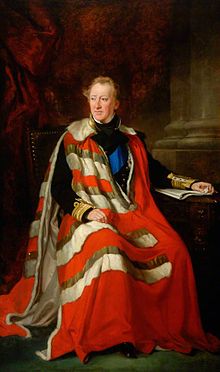Algernon Percy, 4th Duke of Northumberland
The Duke of Northumberland | |
|---|---|
 Duke of Northumberland by Francis Grant | |
| First Lord of the Admiralty | |
| In office 28 February 1852 – 17 December 1852 | |
| Monarch | Queen Victoria |
| Prime Minister | The Earl of Derby |
| Preceded by | Sir Francis Baring, Bt |
| Succeeded by | Sir James Graham, Bt |
| Personal details | |
| Born | 15 December 1792 |
| Died | 12 February 1865 (aged 72) |
| Nationality | British |
| Political party | Conservative |
| Spouse(s) | Lady Eleanor Grosvenor (d. 1911) |
| Relations | Hugh Percy, 2nd Duke of Northumberland (father) |
| Alma mater | St John's College, Cambridge |
| Military service | |
| Allegiance | |
| Branch/service | Royal Navy |
| Years of service | 1805–c.1862 |
| Rank | Admiral |
| Commands | HMS Cossack |
| Battles/wars | Napoleonic Wars |
| Awards | Knight of the Order of the Garter |
Admiral Algernon Percy, 4th Duke of Northumberland KG, PC (15 December 1792 – 12 February 1865), styled Lord Algernon Percy from birth until 1816 and known as Lord Prudhoe between 1816 and 1847, was a British naval commander, explorer and Conservative politician.
Early life
Northumberland was the second son of General Hugh Percy, 2nd Duke of Northumberland, and his second wife Frances Julia, daughter of Peter Burrell.[1] He was educated at Eton and St John's College, Cambridge.[1]
Naval career
Northumberland entered the Royal Navy in March 1805, aged 12, on board HMS Tribune and served in the Napoleonic Wars.[2] In 1815, when only 22, he was promoted to captain, taking command of HMS Cossack in August, and commanding her until she was broken up some 10 months later.[3] The following year, aged 23, he was raised to the peerage as Baron Prudhoe, of Prudhoe Castle in the County of Northumberland (Prudhoe being a town in Northumberland). He later became an Admiral in the Royal Navy.[4] Between 1826 and 1829 he was part of an expedition to Egypt, Nubia and The Levant.[3] In 1834, he travelled to the Cape of Good Hope with John Herschel to study the southern constellations.[3]
Northumberland became the first president of the newly formed National Institution for the Preservation of Life from Shipwreck in 1834, and went on to become the president of its successor, the Royal National Lifeboat Institution. In 1851 he offered a prize of £200 for a new design of self-righting lifeboat, won by James Beeching, which became the standard model for the new Royal National Lifeboat Institution fleet.[5]
Political career
Northumberland succeeded his childless elder brother in the dukedom in 1847. In 1852 he was sworn of the Privy Council[6] and appointed First Lord of the Admiralty, with a seat in the cabinet, by the Earl of Derby, a post he held until the fall of the government in December 1852. In 1853 he was made a Knight of the Garter.[7]
Personal life
Northumberland married, aged 49, Lady Eleanor Grosvenor, daughter of Richard Grosvenor, 2nd Marquess of Westminster, on 25 August 1842 at St George's, Hanover Square. They had no children. As a result of gout in his right hand, he died in February 1865, aged 72 at Alnwick Castle and was buried in the Northumberland Vault, within Westminster Abbey.[1][2][8] He was succeeded in his titles by his cousin, George Percy, 2nd Earl of Beverley, except for the barony of Percy, which passed through the female line to his great-nephew, John Stewart-Murray, 7th Duke of Atholl. The Duchess of Northumberland died on 4 May 1911.[9]
He was a fellow of the Royal Society, the Society of Antiquaries, the Royal Geographical Society, the Royal Astronomical Society, president of the Royal United Services Institute and the Royal Institution, a director of the British Institution and a trustee of the British Museum.[2]
Northumberland was a good friend of Arctic explorer Sir John Franklin, and Prudhoe Bay, on the north coast of Alaska, was named after him.[citation needed]
See also
- O'Byrne, William Richard (1849). . . John Murray – via Wikisource.
References
- ^ a b c "Percy, Algernon (Lord Prudhoe) (PRCY835AL)". A Cambridge Alumni Database. University of Cambridge.
- ^ a b c Sussex Advertiser, 14 February 1865, page 4
- ^ a b c Starkey, Paul, and Starkey, Janet. Travellers in Egypt. Chapter 9: The Journeys of Lord Prudhoe and Major Orlando Felix in Egypt, Nubia and the Levant, 1826–1829. London/New York: Tauris Parke Paperbacks, 2001.
- ^ Kidd, Charles, Williamson, David (editors). Debrett's Peerage and Baronetage (1990 edition). New York: St Martin's Press, 1990.
- ^ Lewis, Richard. History of the Life-Boat, and Its Work (MacMillan & Co., 1874) p. 183 ff. & .
- ^ "No. 21296". The London Gazette. 27 February 1852.
- ^ "No. 21404". The London Gazette. 21 January 1853.
- ^ Elizabeth, Duchess of Northumberland – Westminster Abbey
- ^ thepeerage.com Algernon Percy, 4th Duke of Northumberland
